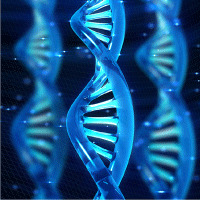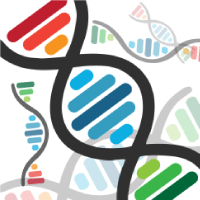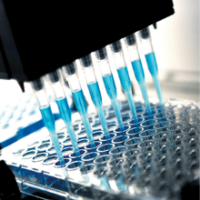| Technology | Magnetic-bead technology |
| Format | Highly reactive superparamagnetic beads |
| Processing | Manual or automated |
| Input material | Reaction mixtures from common NGS library preparation kits |
| Amount of input material | 17.5 pg–5 µg |
| Input volume | 50–150 µl |
| Typical recovery | 80% |
| Elution volume | 10–100 µl |
PRODUCT OVERVIEW
NucleoMag NGS Clean-up and Size Select
The NucleoMag NGS Clean-up and Size Select kit uses magnetic-bead technology to enable efficient cleanup of enzymatic reactions and tunable size selection of DNA fragments for NGS library preparation. The kit makes it possible to selectively target fragments of a given size within a range of ~150–800 bp by varying bead-to-sample volume ratios and performing single- or double-sided size selection (Figure 1). The beads can easily be used in existing NGS library preparation protocols since the recommended dilution ratios are similar to those used with other magnetic bead-based methods.
The NucleoMag NGS Clean-up and Size Select procedure is based on reversible adsorption of DNA fragments to paramagnetic beads. The purified DNA fragments, which are eluted in low-salt buffer or water after an ethanol wash, are free of contaminating nucleotides, primers, adapters, adapter dimers, enzymes, buffer additives, or salts, and can be used directly in downstream applications.
The recovery rates for different fragment sizes vary depending on the bead-to-sample volume ratios employed (Figure 2), and varying volume ratios can be applied in series for double-sided size selection (Figure 3). The NucleoMag NGS Clean-up and Size Select kit has been shown to yield comparable fragment size distributions (Figure 4) and sequencing data (Figure 5) to size-selection beads from other providers.
The NucleoMag NGS Clean-up and Size Select kit offers the following benefits:
- Processing of inputs as low as 17.5 pg and input volumes ranging from 50–150 µl
- Tunable selection of DNA fragments ranging in size from 150–800 bp
- Scalable, automation-friendly magnetic-bead technology
- Comparable performance and dilution ratios to beads from other providers (e.g., AMPure XP)
At-a-glance
Application data

Figure 1. Tunable selection of DNA fragments in a given size range using NucleoMag NGS Clean-up and Size Select. NucleoMag NGS Clean-up and Size Select can be used to isolate DNA fragments of a given size within a target range of ~150–800 bp. Selective binding of DNA fragments above a designated size cutoff is achieved by applying NucleoMag beads to the sample at a predetermined dilution ratio. This approach can be applied once or twice to perform single- or double-sided size selection. In the latter case, an initial round of bead purification is typically performed to bind and remove fragments above the upper size cutoff, and a second round of purification is performed to bind and retain fragments above the lower size cutoff. Dilution ratios used for size selection with NucleoMag beads are similar to ratios employed by size-selection beads from other providers, such that NucleoMag beads can be incorporated in existing NGS library preparation workflows without protocol adjustment.

Figure 2. Relationship between bead-to-sample volume ratio and recovery rate for DNA fragments of different sizes with NucleoMag NGS Clean-up and Size Select. Varying quantities of NucleoMag beads were applied to 100-μl aliquots containing mixtures of DNA fragments ranging in size from 100 bp to 1,000 bp (10 ng/μl) in the indicated dilution ratios (gray row). Recovery rates for fragments of each size are expressed as percentages (%).

Figure 3. Examples of double-sided size selection using NucleoMag NGS Clean-up and Size Select. Sheared mouse genomic DNA was size selected with NucleoMag beads using two different pairs of dilution ratios and measured using a Bioanalyzer. Green trace: sheared mouse genomic DNA prior to size selection. Blue trace: size distribution after double-sided size selection using dilution ratios of 0.55 (right) and 0.8 (left), resulting in a mean fragment size of 340 bp. Red trace: size distribution after double-sided size selection using dilution ratios of 0.4 (right) and 0.6 (left), resulting in a mean fragment size of 460 bp.

Figure 4. Fragment size analysis for NGS libraries prepared using size-selection beads from various providers. NGS libraries were prepared from sheared E. coli DNA using the TruSeq® DNA PCR-Free kit by Illumina and size selected using magnetic beads from different providers (Illumina, Beckman Coulter [AMPure XP], and Takara Bio [NucleoMag NGS Clean-up and Size Select]). Panel A. Bioanalyzer trace indicating size distribution of sheared E. coli DNA (1-μg input) prior to NGS library preparation. Panel B. Bioanalyzer traces indicating size distributions of resulting NGS libraries purified using Illumina (red), AMPure XP (blue), or NucleoMag (green) magnetic beads.

Figure 5. Comparison of sequencing data generated from NGS libraries prepared using size-selection beads from various providers. NGS libraries were prepared using the TruSeq DNA PCR-Free kit by Illumina and size selected using magnetic beads from different providers (Illumina, Beckman Coulter [AMPure XP], and Takara Bio [NucleoMag NGS Clean-up and Size Select; MN beads]). Sequencing was performed on a HiSeq® 2500 using the TruSeq Rapid SBS Kit. Panel A. Genome sequence coverage distributions for NGS libraries prepared using Illumina (red), AMPure XP (blue), or NucleoMag (green) size-selection beads. Normalized read depths for mapped bases are binned along the X axis. Frequencies of reference bases covered at the corresponding read depths are indicated on the Y axis. Overlap of the coverage distributions indicates comparable performance of the respective size-selection beads. Panel B. Comparison of genome sequence coverage as a function of GC content for NGS libraries prepared using NucleoMag (MN) and AMPure XP size-selection beads. Ratios of mapped-base read depths for the respective NGS libraries were analyzed as a function of GC content using 0.5-kb windows. Ratios close to 1 indicate comparable representation of mapped reads in the datasets for the respective NGS libraries.
Associated publications
Tian, L. et al. Benchmarking single cell RNA-sequencing analysis pipelines using mixture control experiments. Nat Methods. 16, 479-487 (2019).
McKenzie, MD. et al. Interconversion between Tumorigenic and Differentiated States in Acute Myeloid Leukemia. Cell Stem Cell. 25, 258-272 (2019).
Kubik, S. et al. Opposing chromatin remodelers control transcription initiation frequency and start site selection. Nat Struct Mol Biol. 26, 744-754 (2019).
Alcala, N. et al. Integrative and comparative genomic analyses identify clinically relevant pulmonary carcinoid groups and unveil the supra-carcinoids. Nat Commun. 10, 3407 (2019).
Keller, A. et al. Wild bees and their nests host Paenibacillus bacteria with functional potential of avail. Microbiome. 6, 229 (2018).
Derks, JL. et al. Molecular Subtypes of Pulmonary Large-cell Neuroendocrine Carcinoma Predict Chemotherapy Treatment Outcome. Clin Cancer Res. 24, 33-42 (2018).
Challal, D. et al. General Regulatory Factors Control the Fidelity of Transcription by Restricting Non-coding and Ectopic Initiation. Mol Cell. 72, 955-969 (2018).
Chauvin, C. et al. NKG2D controls natural reactivity of Vγ9Vδ2 T lymphocytes against mesenchymal glioblastoma cells. Clin Cancer Res. 25, 7218-28 (2019).
Villalobos, A. et al. Systematic Affiliation and Genome Analysis of Subtercola vilae DB165T with Particular Emphasis on Cold Adaptation of an Isolate from a High-Altitude Cold Volcano Lake. Microorganisms. 7, 107 (2019).
Dagher, D. et al. Plant Identity Shaped Rhizospheric Microbial Communities More Strongly Than Bacterial Bioaugmentation in Petroleum Hydrocarbon-Polluted Sediments. Front Microbiol. 10, 2144 (2019).
Simon, B. et al. Whole Genome Sequencing of A(H3N2) Influenza Viruses Reveals Variants Associated with Severity during the 2016-2017 Season. Viruses. 11, 108 (2019).
Wemheuer, F. et al. Primary Production in the Water Column as Major Structuring Element of the Biogeographical Distribution and Function of Archaea in Deep-Sea Sediments of the Central Pacific Ocean. Archaea. 2019, 3717239 (2019).
Prazeres, M. Bleaching-Associated Changes in the Microbiome of Large Benthic Foraminifera of the Great Barrier Reef, Australia. Front Microbiol. 9, 2404 (2018).
Pohlner, M. et al. The Biogeographical Distribution of Benthic Roseobacter Group Members along a Pacific Transect Is Structured by Nutrient Availability within the Sediments and Primary Production in Different Oceanic Provinces. Front Microbiol. 8, 2550 (2017).
Horn, H. et al. Draft genome of the Arabidopsis thaliana phyllosphere bacterium, Williamsia sp. ARP1. Stand Genomic Sci. 11, 8 (2016).
Massilani, D. et al. Past climate changes, population dynamics and the origin of Bison in Europe. BMC Biol. 14, 93 (2016).
Related Products
Takara Bio USA, Inc.
United States/Canada: +1.800.662.2566 • Asia Pacific: +1.650.919.7300 • Europe: +33.(0)1.3904.6880 • Japan: +81.(0)77.565.6999
FOR RESEARCH USE ONLY. NOT FOR USE IN DIAGNOSTIC PROCEDURES. © 2025 Takara Bio Inc. All Rights Reserved. All trademarks are the property of Takara Bio Inc. or its affiliate(s) in the U.S. and/or other countries or their respective owners. Certain trademarks may not be registered in all jurisdictions. Additional product, intellectual property, and restricted use information is available at takarabio.com.






